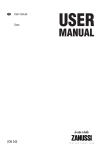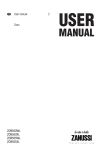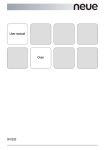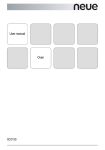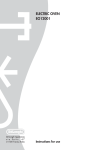Download Zanussi ZOB 383 User's Manual
Transcript
EN User manual Oven ZOB 383 Contents Safety information _ _ _ _ _ _ _ _ _ _ _ _ _ _ _ _ Product description _ _ _ _ _ _ _ _ _ _ _ _ _ _ _ _ Before first use _ _ _ _ _ _ _ _ _ _ _ _ _ _ _ _ _ _ Daily use _ _ _ _ _ _ _ _ _ _ _ _ _ _ _ _ _ _ _ _ _ Hints, tips and cooking tables _ _ _ _ _ _ _ _ _ _ _ 2 4 4 5 7 Care and cleaning _ _ _ _ _ _ _ _ _ _ _ _ _ _ _ _ What to do if… _ _ _ _ _ _ _ _ _ _ _ _ _ _ _ _ _ Installation _ _ _ _ _ _ _ _ _ _ _ _ _ _ _ _ _ _ _ Environment concerns _ _ _ _ _ _ _ _ _ _ _ _ _ _ 11 12 13 14 Subject to change without notice Safety information Before the installation and use, read this manual carefully: • For your personal safety and the safety of your property • For the respect of the environment • For the correct operation of the appliance. Always keep these instructions with the appliance also if you move or sell it. The manufacturer is not responsible if incorrect installation or use results in damage. Children and vulnerable people safety • Do not let persons, children included, with reduced physical sensory, reduced mental functions or lack of experience and knowledge to use the appliance. They must have supervision or instruction for the operation of the appliance by a person who is responsible for their safety. • Keep all packaging away from children. There is the risk of suffocation or physical injury. • Keep children and small animals away from the appliance when the door is open or the appliance is in operation. There is the risk of injury or other permanent disability. • If the appliance has Switch-on lock or Key lock function, use it. It prevents children and small animals from accidental use of the appliance. General safety • Do not change the specifications of this appliance. There is the risk of injury and damage to the appliance. • Do not let the appliance stay unattended during operation. • Switch off the appliance after each use. Installation • Only an approved electrician can install and connect the appliance. Contact an approved service centre. This 2 • • • • • • • • • • • • is to prevent the risks of structural damage or physical injury. Make sure that the appliance is not damaged because of transport. Do not connect a damaged appliance. If necessary, contact the supplier. Remove all packaging, stickers and layers from the appliance before first use. Do not remove the rating plate. It can invalidate the guarantee. Fully obey the laws, ordinances, directives and standards in force in the country where you use the appliance (safety regulations, recycling regulations, electrical or gas safety rules etc.). Make sure that the appliance is disconnected from the power supply during the installation. Be careful when you move the appliance. The appliance is heavy. Always use safety gloves. Do not pull the appliance by the handle. The electrical installation must have an isolation device which lets you disconnect the appliance from the mains at all poles. The isolation device must have a contact opening width of minimum 3 mm. You must have correct isolation devices: line protecting cut-outs, fuses (screw type fuses removed from the holder), earth leakage trips and contactors. The shock protection parts must be fixed in such a way that they cannot be undone without tools. Some parts of the appliance carry current. Close the appliance with furniture and make sure that there are no free spaces. It prevents electrical shock because you cannot accidentally touch dangerous parts. Before the installation, make sure that the kitchen cabinet has the recess dimensions applicable. Make sure that the appliance is installed below and adjacent safe structures. Keep the minimum distances to the other appliances and units. • Install the appliance with its back and one side close to the higher appliance. The other side must be close to appliance with the same height. • The appliance cannot be positioned on a base. • Built in ovens and built in cooking surfaces are attached with special connection system. To prevent damage to the appliance, only use an appliance with the appliances from the same manufacturer. Electrical connection • The appliance must be earthed. • Make sure that the electrical data on the rating plate agree with your domestic power supply. • Information on the voltage is on the rating plate. • Always use a correctly installed shockproof socket. • When you connect electrical appliances to mains sockets, do not let cables touch or come near the hot appliance door. • Do not use multi-way plugs, connectors and extension cables. There is the risk of fire. • Do not replace or change the mains cable. Contact the service centre. • Make sure not to squash or cause damage to the mains plug (if applicable) and cable behind the appliance. • Make sure that the mains connection is accessible after the installation. • Do not pull the mains cable to disconnect the appliance. Always pull the mains plug – if applicable. Use • The appliance is only for domestic use. Do not use the appliance for commercial and industrial use. • Only use the appliance for domestic cooking tasks. This is to prevent physical injury to persons or prevent damage to property. • Do not use the appliance as a work surface or storage surface. • Do not put flammable products or items that are wet with flammable products, and/or fusible objects (made of plastic or aluminium) in, near or on the appliance. There is the risk of explosion or fire. • The interior of the appliance becomes hot during use. There is the risk of burns. Use gloves when you insert or remove the accessories or pots. • Be careful when you remove or install the accessories to prevent damage to the oven enamel. • Always stay away from the appliance when you open the door while the appliance is in operation. Hot steam can release. There is the risk of skin burns. • To prevent damage or discoloration to the enamel: – do not put any objects directly on the appliance floor and do not cover it with aluminium foil; – do not put hot water directly into the appliance; – do not keep moist dishes and food in the appliance after you finish the cooking. • Discoloration of the enamel has no effect on the performance of the appliance • Do not use this appliance if it is in contact with water. Do not operate the appliance with wet hands. • Do not apply pressure on the open door. • Always close the appliance door when you cook, even while grilling. Care and cleaning • Before maintenance, switch off the appliance and disconnect the appliance from the power supply. • Before maintenance, make sure that the appliance is cold. There is the risk of burns. There is the risk that the glass panels can break. • Keep the appliance clean at all times. A build-up of fats or other foodstuff can result in a fire. • Regular cleaning prevents the surface material from deteriorating • For your personal safety and the safety of your property, only clean the appliance with water and a soap. Do not use flammable products or products that can cause corrosion. • Do not clean the appliance with steam cleaners, highpressure cleaners, sharp objects, abrasive cleaning agents, abrasive sponges and stain removers • If you use an oven spray, follow the instructions from the manufacturer. Do not spray anything on the heating elements and the thermostat sensor. • Do not clean the glass door with abrasive cleaning agents or metal scraper. Heat resistant surface of the inner glass can break and shatter. • When the door glass panels are damaged they become weak and can break. You must replace them. Contact the service centre. • Be careful when you remove the door from the appliance. The door is heavy! • Do not clean catalytic enamel (if applicable). 3 Oven lamp Disposal of the appliance • Disconnect the appliance from the power supply before the replacement of the oven lamp. There is the risk of electrical shock! • To prevent the risk of physical injury or damage – Disconnect the appliance from the power supply. – Cut off the mains cable and discard it. – Discard the door catch. This prevents children or small animals from being closed inside of the appliance. There is the risk of suffocation. Service centre • Only an approved engineer can repair or work on the appliance. Contact an approved service centre. • Use only original spare parts. Product description General overview 2 3 4 5 1 6 7 8 10 9 Oven accessories • Oven shelf For cookware, cake tins, roasts. • Deep roasting pan Before first use Warning! Refer to "Safety information" chapter. Setting the time The oven only operates after time set. 4 1 2 3 4 5 6 7 8 9 10 Control panel Temperature indicator Temperature control knob Display Oven function control knob Air vents for the cooling fan Heating element Oven lamp Rating plate Fan To bake and roast or as pan to collect fat. • The roasting pan grid To put in the deep roasting pan. Preheating 1. Set function and maximum temperature. 2. Run an empty oven for 45 minutes. 3. Set function and maximum temperature. 4. Run an empty oven for 15 minutes. This is to burn off any residue from the cavity surface. Accessories can become more hot than in normal use. During this period an odour and smoke can be emitted. This is normal. Make sure the airflow is sufficient. Initial Cleaning When you connect the appliance to the electrical supply or in case of a power cut, the Time function indicator flashes automatically. To set the current time use " + " or " - " button. After approximately 5 seconds, the flashing stops and the display shows the time of day set. • Remove all parts from the appliance. • Clean the appliance before first use. Caution! Do not use abrasive cleaning agents! This can damage the surface. Refer to chapter "Care and Cleaning". For time change you must not set an automatic function (Duration or End ) at the same time. Daily use Warning! Refer to "Safety information" chapter. Switching the Oven On and Off 1. Turn the oven functions control knob to an oven function. 2. Turn the temperature control knob to a temperature. The temperature indicator comes on while the oven temperature increases. 3. To switch off the oven, turn the oven functions control knob and the temperature control knob to the Off position. Oven Functions Oven function Application OFF position The appliance is OFF. Oven lamp Lights up without any cooking function. Conventional cooking Heats both from the top and bottom element. To bake and roast on one oven level. Top heating element Heats only from the top of the oven. To finish cooked dishes. Bottom heating element Heats only from the bottom of the oven. To bake cakes with crispy or crusty bases. Grill To grill flat food items in small quantities in the middle of the shelf. To make toasts 5 Oven function Application Dual grill The full grill element is on. To grill flat food items in large quantities. To make toasts. Thermal grilling The grill element and the oven fan operate alternately and circulate hot air around the food. To cook large pieces of meat. Maximum temperature for this function is 200 °C . Fan cooking To roast or roast and bake the food that requires the same cooking temperature, using more than one shelf, without flavour transference. Defrost Thaws frozen food. The temperature control knob must be on off position. Display 1 2 6 5 3 Minute minder Application Shows the time. To set, change or check the time. To set a countdown time. A signal sounds, after the time period is completed. This function has no effect on the operation of the oven. Duration To set how long the oven has to be in operation. End To set the switch-off time for an oven function. Duration and End can be used at the same time, if the oven is to be switched on and off auto, then matically later. In this case first set Duration End . Setting the clock functions 1. Press the Selection button again and again until necessary function indicator flashes. 6 Function Indicators Time display Function Indicators Button "+" Selector Button Button "-" 4 Clock function Time of day 1 2 3 4 5 6 2. To set the time for Minute minder , Duration or End , press " + " or " - " button. The related function indicator comes on. When the time period ends, the function indicator flashes and an acoustic signal sounds for 2 minutes. and End the With the functions Duration oven switches off automatically. 3. Press any button to stop the signal. 4. Turn the oven function control knob and the temperature control knob to the Off position. Cancelling the clock functions 1. Push the Selection button again and again until necessary function indicator flashes. 2. Push and hold button " - ". After some seconds the clock function goes out. Other Functions Cooling fan When the appliance operates, the cooling fan switches on automatically to keep the surfaces of the appliance cool. If you switch off the appliance, the cooling fan continues to operate until the appliance cools down. Safety thermostat To prevent dangerous overheating (due to incorrect use of the appliance or defective components), the oven has a safety thermostat, which interrupts the power supply. The oven switches back on again automatically, when the temperature drops. Hints, tips and cooking tables Warning! Refer to "Safety information" chapter. Information on acrylamides Important! According to the newest scientific knowledge, if you brown food (specially the one which contains starch), acrylamides can pose a health risk. Thus, we recommend that you cook at the lowest temperatures and do not brown food too much. • The appliance has four shelf levels. Count the shelf levels from the bottom of the appliance floor. • You can cook different dishes on two levels at the same time. Place the shelves on level 1 and 3. • The appliance has a special system which circulates the air and constantly recycles the steam. With this system you can to cook in a steamy environment and keep the food soft inside and crusty outside. It decreases the cooking time and energy consumption to a minimum. • Moisture can condense in the appliance or on the glass doors. This is normal. Always stand back form the appliance when you open the appliance door while cooking. To decrease the condensation, run the appliance for 10 minutes before cooking. • Wipe away moisture after every use of the appliance. • Do not put the objects directly on the appliance floor and do not cover the components with aluminium foil when you cook. This can change the baking results and damage the enamel coating. Baking cakes • The best temperature for baking cakes is between 150°C and 200°C. • Preheat the oven for approximately 10 minutes before baking. • Do not open the oven door before 3/4 of the set cooking time is up. • If you use two baking trays at the same time, keep one level empty between them. Cooking meat and fish • Do not cook meat with weight below 1 kg. Cooking too small quantities makes the meat too dry. • To keep the red meat well cooked outside and juicy inside set the temperature between 200°C-250°C. • For white meat, poultry and fish set the temperature between 150°C-175°C. • Use a dripping pan for very fatty food to prevent the oven from stains that can be permanent. • Leave the meat for approximately 15 minutes before carving so that the juice does not seep out. • To prevent too much smoke in the oven during roasting, add some water into the dripping pan. To prevent the smoke condensation, add water each time after it dries up. Cooking times Cooking times depend on the type of food, its consistency, and volume. 7 Initially, monitor the performance when you cook. Find the best settings (heat setting, cooking time, etc.) for your cookware, recipes and quantities when you use this appliance. Baking and roasting table CAKES Conventional cooking Fan cooking Cooking time [min] Notes 160 45-60 In cake mould 2 (1 and 3) 160 24-34 In cake mould 170 2 160 60-80 In cake mould 26 cm 1 170 2 left + right 160 100-120 2 cake moulds of 20 cm on the oven shelf Strudel 2 175 2 150 60-80 On baking tray Jam- tart 2 170 2 160 30-40 In cake mould 26 cm Fruit cake 2 170 2 155 60-70 In cake mould 26 cm Sponge cake (Fatless sponge cake) 2 170 2 160 35-45 In cake mould 26 cm Christmas cake/ Rich fruit cake 2 170 2 160 50-60 In cake mould 20 cm Plum cake 2 170 2 160 50-60 In bread tin 1) Small cakes 3 170 3 (1 and 3) 160 20-30 On flat baking tray Biscuits 3 150 3 150 20-30 On flat baking tray1) Meringues 3 100 3 100 90-120 On flat baking tray Buns 3 190 3 180 15-20 On flat baking tray1) Choux 3 190 3 180 25-35 On flat baking tray1) Plate tarts 3 180 2 170 45-70 In cake mould 20 cm 1 or 2 180 2 170 40-55 Left + right in cake mould 20 cm TYPE OF DISH Level Temp [°C] Level Temp [°C] Whisked recipies 2 170 2 (1 and 3) Shortbread dough 2 170 Butter-milk cheese cake 1 Apple cake (Apple pie) Victoria sandwich 1) Preheat for 10 minutes. 8 BREAD AND PIZZA TYPE OF DISH Conventional cooking Fan cooking Cooking time [min] Notes 190 60-70 1-2 pieces, 500 gr one piece1) 1 180 30-45 In bread tin 190 2 (1 and 3) 180 25-40 6-8 rolls on flat baking tray 1) 1 190 1 190 20-30 On deep roasting pan1) 3 200 2 190 10~20 On flat baking tray1) Cooking time [min] Notes Level Temp [°C] Level Temp [°C] White bread 1 190 1 Rye bread 1 190 Bread rolls 2 Pizza Scones 1) Preheat for 10 minutes. FLANS TYPE OF DISH Conventional cooking Fan cooking Level Temp [°C] Level Temp [°C] Vegetable flan 2 200 2 175 45-60 In mould Quiches 1 190 1 190 40-50 In mould Lasagne 2 200 2 200 25-40 In mould Cannelloni 2 200 2 190 25-40 In mould Yorkshire pudding 2 220 2 210 20-30 6 pudding mould 1) Cooking time [min] Notes 1) Preheat for 10 minutes. MEAT TYPE OF DISH Conventional cooking Level Fan cooking Temp [°C] Level Temp [°C] Beef 2 200 2 190 50-70 On oven shelf and deep roasting pan Pork 2 180 2 180 90-120 On oven shelf and deep roasting pan Veal 2 190 2 175 90-120 On oven shelf and deep roasting pan English roast beef rare 2 210 2 200 44-50 On oven shelf and deep roasting pan 9 TYPE OF DISH Conventional cooking Level Fan cooking Temp [°C] Level Temp [°C] Cooking time [min] Notes English roast beef medium 2 210 2 200 51-55 On oven shelf and deep roasting pan English roast beef well done 2 210 2 200 55-60 On oven shelf and deep roasting pan Shoulder of pork 2 180 2 170 120-150 On deep roasting pan Shin of pork 2 180 2 160 100-120 2 pieces on deep roasting pan Lamb 2 190 2 190 110-130 Leg Chicken 2 200 2 200 70-85 Whole on deep roasting pan Turkey 1 180 1 160 210-240 Whole on deep roasting pan Duck 2 175 2 160 120-150 Whole on deep roasting pan Goose 1 175 1 160 150-200 Whole on deep roasting pan Rabbit 2 190 2 175 60-80 Cut in pieces Hare 2 190 2 175 150-200 Cut in pieces Pheasant 2 190 2 175 90-120 Whole on deep roasting pan Cooking time [min] Notes FISH TYPE OF DISH Conventional cooking Fan cooking Level Temp [°C] Level Temp [°C] Trout/Sea bream 2 190 2 (1 and 3) 175 40-55 3-4 fishes Tuna fish/Salmon 2 190 2 (1 and 3) 175 35-60 4-6 fillets Grilling Preheat the empty oven for 10 minutes, before cooking. Quantity TYPE OF DISH Grilling Pieces g Fillet steaks 4 800 Beef steaks 4 600 Sausages 8 / 10 Cooking time in minutes Temp. (°C) 1st side 2nd side 3 250 12-15 12-14 3 250 10-12 6-8 3 250 12-15 10-12 level Quantity TYPE OF DISH Grilling Pieces g level Cooking time in minutes Temp. (°C) 1st side 2nd side Pork chops 4 600 3 250 12-16 12-14 Chicken (cut in 2) 2 1000 3 250 30-35 25-30 Kebabs 4 / 3 250 10-15 10-12 Breast of chicken 4 400 3 250 12-15 12-14 Hamburger 6 600 3 250 20-30 Fish Fillet 4 400 3 250 12-14 Toasted sandwiches 4-6 / 3 250 5-7 / Toast 4-6 / 3 250 2-4 2-3 10-12 Thermal grilling Warning! Use this function with a maximum temperature of 200°C. Quantity TYPE OF DISH Grilling Pieces g Rolled joints (turkey) 1 1000 Chicken (cut in two) 2 Chicken drumsticks 6 Quail Vegetable gratin pieces. Scallops Cooking time in minutes Temp. (°C) 1st side 2nd side 3 200 30-40 20-30 1000 3 200 25-30 20-30 - 3 200 15-20 15-18 4 500 3 200 25-30 20-25 - - 3 200 20-25 - level - - 3 200 15-20 - Mackerel 2-4 - 3 200 15-20 10-15 Fish slices 4-6 800 3 200 12-15 8-10 Care and cleaning Warning! Refer to "Safety information" chapter. Cleaning the oven door The oven door has two panels of glass installed one behind the other. You can remove the glass panel to clean it. door. The oven door can close if you try to remove the internal panel of glass before you remove the oven 11 90° 1 1 Open the door fully and hold the two door hinges. 2 Lift and turn the levers on the two hinges. 2 6 Turn 2 fasteners by 7 Carefully lift and re90° and remove them from move the panel of glass. their seats. Clean the glass panel with water and soap. Dry the glass panel carefully. Installing the door and the glass panel 3 Close the oven door to 4 Place the door on a the first opening position stable surface protected (halfway). Then pull for- by a soft cloth. ward and remove it from its seat. Place the door on a stable surface protected by a soft cloth. After cleaning, install the glass panel in opposite order. Make sure that when you install the internal panel with a decorative frame, the screen-printing is on the outer side. Make sure that the surface of the glass panel frame is not rough when you touch it. Make sure that you put the internal panel of glass to the correct seats (refer to the picture). Replacing the oven light bulb/cleaning the glass cover 5 Release the locking system to remove the internal panel of glass. What to do if… Warning! Refer to "Safety information" chapter. 12 Warning! Be careful! There is the risk of electrical shock! 1. Turn the glass cover anti-clockwise to remove it. 2. Clean the glass cover. 3. Replace the oven light bulb with applicable 300°C heat-resistant oven light bulb. New oven light bulb must have the same parameters as your previous one. 4. Install the glass cover. Problem Possible cause Remedy The oven does not heat up The oven is not switched on Switch on the oven The oven does not heat up The clock is not set Set the clock The oven does not heat up The necessary settings are not set Control the settings The oven does not heat up The fuse in the fuse box is released Control the fuse. If the fuse is released more than one time, refer to a qualified electrician. The oven lamp does not operate The oven lamp is defective Replace the oven lamp Steam and condensation settle on the You left the dish in the oven for too food and in the oven cavity long Do not leave the dishes in the oven for longer than 15-20 minutes after the cooking process ends The display shows “12.00” Reset the clock A power cut If you cannot find a solution to the problem yourself, contact your dealer or the service centre. The necessary data for the service centre is on the rating plate. The rating plate is on the front frame of the oven cavity. We recommend that you write the data here: Model (MOD.) ......................................... Product number (PNC) ......................................... Serial number (S.N.) ......................................... Installation Warning! Refer to "Safety information" chapter. A 540 50 560 2 in 550 m 560 ÷57 0 580 B 570 590 20 594 Electrical installation Important! The manufacturer is not responsible if you do not obey the safety precautions from chapter "Safety". 560 593 in 550 m 80 -570 0 0 ÷1 This appliance is supplied without a main plug and a main cable. Applicable types of cables for Europe: H07 RN-F, H05 RN-F, H05 RRF, H05 VV-F, H05 V2V2-F (T90), H05 BBF 13 Applicable types of cables for UK only Connection via Min. size Cable/flex Cable/flex type Fuse • 13 A socket outlet • 13 A spur box 2,5 mm² Three core butyl insulated 13 A min. Oven Control Circuit 2,5 mm² PVC/PVC twin and earth 15 A min. 20 A min. Environment concerns The symbol on the product or on its packaging indicates that this product may not be treated as household waste. Instead it should be taken to the appropriate collection point for the recycling of electrical and electronic equipment. By ensuring this product is disposed of correctly, you will help prevent potential negative consequences for the environment and human health, which could otherwise be caused by inappropriate waste handling of this product. For more detailed 14 information about recycling of this product, please contact your local council, your household waste disposal service or the shop where you purchased the product. Packaging material The packaging material is environmentally-friendly and recyclable. Plastic parts are marked with international abbreviations such as PE, PS, etc. Dispose of the packaging material in the containers provided for this purpose at your local waste management facility. 15 397152801-C-032010 www.zanussi.com/shop
















